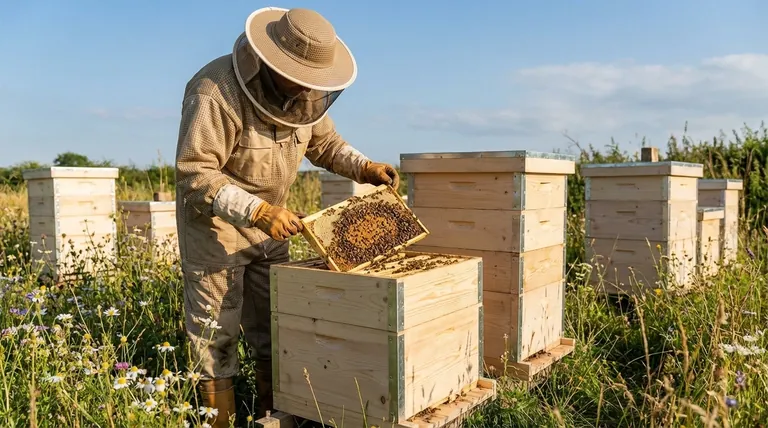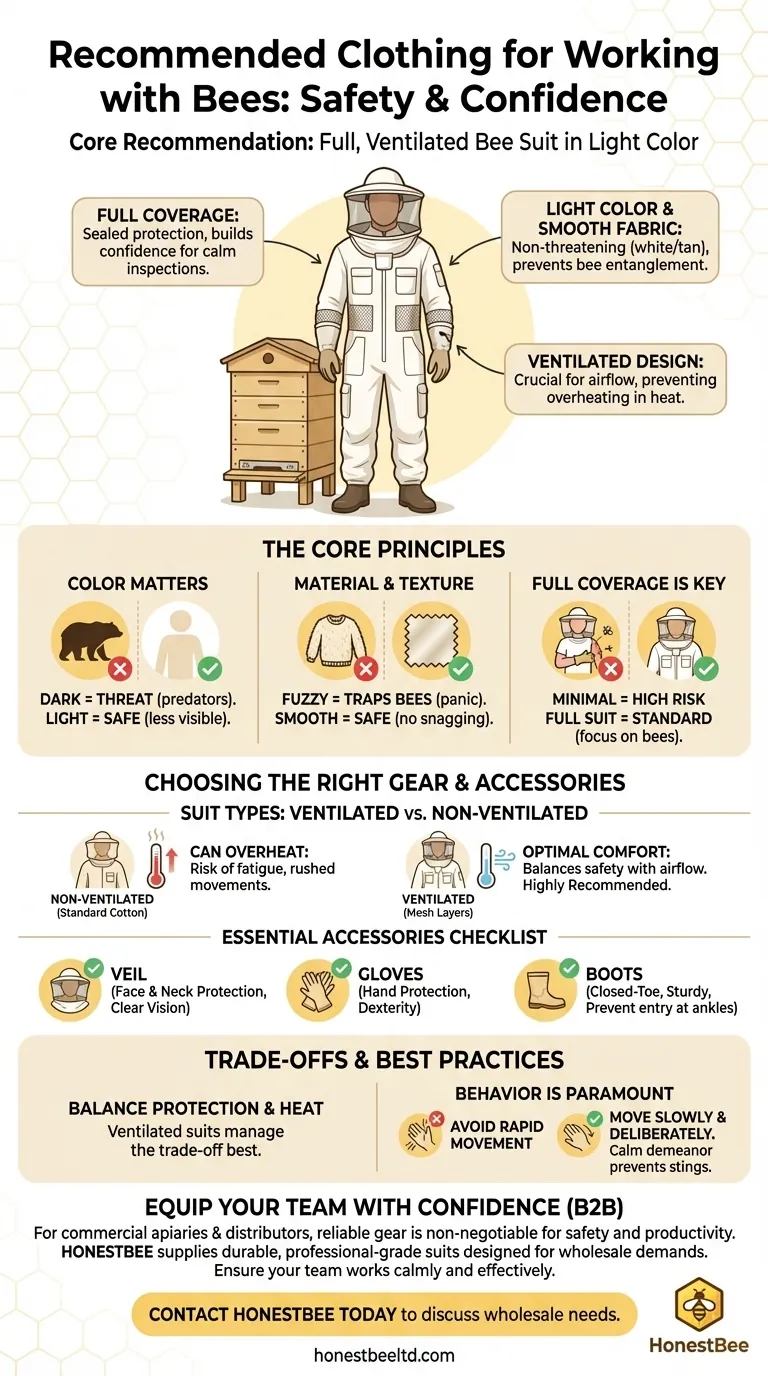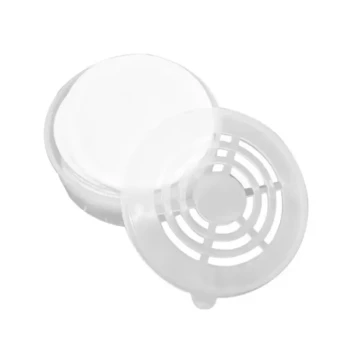For working with bees, the most effective protective clothing is a full bee suit, preferably a ventilated model in a light color like white or tan. This setup is recommended over individual pieces because it offers complete, sealed protection, which is crucial for preventing stings and building the confidence necessary for calm hive inspections.
The goal of your protective gear is twofold: to make you functionally invisible to bees by avoiding threatening colors and textures, and to give you the physical protection needed to remain calm and deliberate in your movements.

The Core Principles of Protective Bee Clothing
Understanding why certain clothing is recommended is key to making the right choice. A bee's defensive response is triggered by perceived threats, and your attire is the first line of communication.
Why Color Matters
Bees have evolved to recognize dark colors as a threat, often associating them with natural predators like bears or badgers.
Wearing light colors such as white, tan, or light gray makes you less of a target. Dark colors should be strictly avoided as they can provoke a more defensive reaction from the colony.
The Importance of Material and Texture
Bees can become entangled in fuzzy or heavily textured materials, causing them to panic and sting.
Opt for smooth fabrics like ripstop nylon or cotton. Avoid wool, fleece, or other animal fibers that can mimic the fur of a predator and trap bees.
Full Coverage is Non-Negotiable
While experienced beekeepers may sometimes use minimal protection, this is not advisable for most. A single sting can disrupt your focus, leading to sudden movements that agitate the hive further.
For anyone who is not completely accustomed to being stung, a full bee suit is the standard. It provides comprehensive protection that allows you to focus on the bees rather than on your own safety.
Choosing the Right Suit and Accessories
Not all bee suits are created equal. The right choice depends heavily on your climate and personal comfort.
Ventilated vs. Non-Ventilated Suits
Standard bee suits made from thick cotton or nylon can become extremely hot, especially during summer hive inspections.
A ventilated suit is constructed with layers of mesh that allow for significant airflow while still preventing stings. This is a highly recommended feature for comfort and to reduce the risk of overheating.
Beyond the Suit: Veils, Gloves, and Footwear
Your protective system is only as strong as its weakest point. Bees will seek out any exposed area.
A good bee veil is essential to protect your face and neck. Ensure it offers clear visibility. Gloves are also critical for protecting your hands, and sturdy, closed-toe boots will prevent bees from crawling up your pant legs.
Understanding the Trade-offs and Best Practices
Protective clothing is your primary tool for safety, but its effectiveness is tied directly to your behavior.
The Balance Between Protection and Heat
The most protective gear can sometimes be the warmest. This is a critical trade-off to manage.
Overheating can lead to fatigue and rushed movements, which is dangerous when working with bees. This is why investing in a ventilated suit is often the most practical solution, balancing complete safety with physical comfort.
Clothing is Only Part of the Equation
Your suit provides protection, but your actions determine whether it will be tested. Bees are primarily agitated by rapid movements and loud noises.
Always move slowly and deliberately when around a hive. Avoid swatting at bees or making sudden gestures. A calm demeanor is just as important as a quality bee suit for preventing stings.
Making the Right Choice for Your Situation
Select your gear based on your experience level and local climate to ensure safety and comfort.
- If you are a beginner: Prioritize a full, ventilated bee suit to gain maximum protection and build confidence working with your hives.
- If you work in a hot climate: A ventilated suit is an essential investment to prevent overheating and maintain the calm focus required for beekeeping.
- If you are inspecting a gentle hive quickly: An experienced beekeeper might only use a veil and light-colored clothing, but this always carries a higher risk.
Ultimately, proper protective gear empowers you to work confidently and focus on the health and productivity of your bees.
Summary Table:
| Gear Type | Key Feature | Why It's Recommended |
|---|---|---|
| Full Bee Suit | Full-body coverage, sealed seams | Provides complete protection, essential for beginners and confidence building. |
| Ventilated Suit | Mesh layers for airflow | Prevents overheating, crucial for comfort and maintaining calm in hot climates. |
| Light Colors | White, tan, or light gray | Makes you less visible and threatening to bees, reducing defensive reactions. |
| Smooth Fabrics | Ripstop nylon or cotton | Prevents bees from getting trapped, unlike fuzzy materials that mimic predators. |
| Essential Accessories | Veil, gloves, closed-toe boots | Protects vulnerable areas like face, hands, and ankles from stings. |
Equip yourself with confidence and safety.
For commercial apiaries and distributors, having reliable, high-quality protective gear is non-negotiable for the safety of your team and the productivity of your operations. HONESTBEE supplies durable, professional-grade beekeeping suits and equipment designed for the demands of wholesale beekeeping.
We understand that your business depends on efficient and safe hive management. Our ventilated suits and full protective kits help your beekeepers work calmly and effectively, minimizing stings and maximizing focus.
Contact HONESTBEE today to discuss your wholesale needs and ensure your team has the best protection available.
Visual Guide

Related Products
- Wholesales Dadant Size Wooden Bee Hives for Beekeeping
- Yellow Plastic Bucket Pail Perch for Beekeeping
- Professional Insulated Winter Hive Wrap for Beekeeping
- Long Langstroth Style Horizontal Top Bar Hive for Wholesale
- Automatic Honey Flow Beehive 4 Frame Mini Hive for Beekeeping
People Also Ask
- What are the advantages of wooden bee hives? Superior Bee Health & Beekeeper Flexibility
- What are the characteristics of oil-based paint for beehives? Durability vs. Modern Practicality
- What types of products are available for beekeeping needs? Essential Equipment for Apiaries & Distributors
- What are the essential pieces of equipment for most beekeepers? Get Started with the Right Gear
- How often should the area under beehives be inspected and cleaned during the warm season? A Proactive Maintenance Guide



















